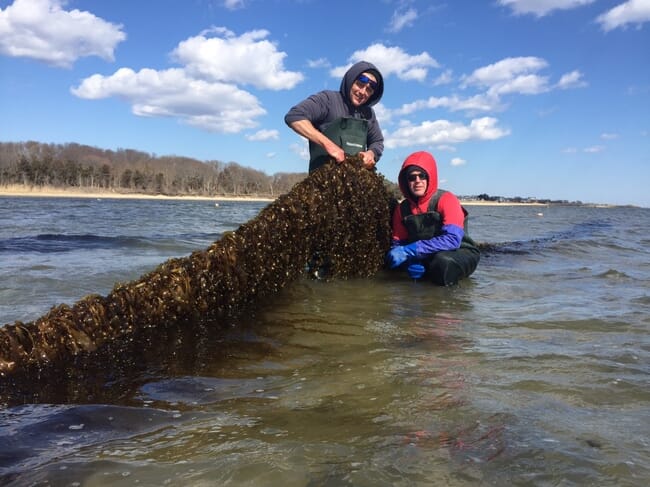So concludes a report from Stony Brook University (SBU), which notes that sugar kelp (Saccharina latissma) could offer the perfect species for the region’s oyster farmers to diversify into – making them less vulnerable to crop failures or downturns in the market for oysters.

© Stony Brook University
This winter a collaborative team, including scientists from SBU, innovators at the non-profit organisation GreenWave, local seafood industry pioneers from Dock to Dish and Haskell Seafood, and several Long Island oyster farmers, have teamed up on a grant to SBU from the New York Farm Viability Institute to bring this crop to Long Island. The team deployed lines of kelp on oyster farms in three estuaries around Long Island, including Great Gun Oyster Farm in Moriches Bay, East End Oysters in Long Island Sound, and a Town of Islip aquaculture lease in Great South Bay.
“The results have been astonishing. In just three months, kelp blades have grown to over four feet at one of the sites, outpacing every known kelp farm in NY and CT,” says SBU in a statement.
“The implications of our study for Long Island oyster farmers are very exciting,” says project co-leader Michael Doall, a marine restoration and aquaculture specialist at SBU’s School of Marine and Atmospheric Sciences (SoMAS). “Kelp farming can provide Long Island oyster farmers with a means to diversify crops, create additive revenue streams, and further contribute to the sustainability and health of Long Island’s estuaries through restorative aquaculture.”
While conventional wisdom states that kelp farming needs to be done in water at least 20 feet deep, so that the kelp blades do not touch the sea bed, many of the existing oyster farms on Long Island are located in shallow estuaries. To the research team’s surprise, kelp has grown the best at the shallowest site in Moriches Bay, where low-tide water depths ranged down to just a foot. Despite this, the kelp has grown from seed to over 4-feet in length with the kelp blades clean and intact, free of fouling or damage.
“It’s astonishing to see how fast this beautiful plant grows,” says Paul McCormick, owner of Great Gun Oyster Farm in Moriches Bay. “It’s a low-maintenance crop that grows in the dead of winter, so it fits in perfectly with the cycle of my farm, offering additional income during a tough time of the year; I’m definitely interested in incorporating kelp on the farm.”
And beyond its remarkable nutritional profile, kelp holds the promise to improve water quality across Long Island waters – the combined farming of kelp and oysters is recognised as “regenerative and restorative” aquaculture, as the organisms collectively sequester nitrogen and carbon from estuaries. Furthermore, the kelp produces oxygen, combats ocean acidification by removing carbon dioxide and may even combat harmful algal blooms.
“Long Island is in a battle to improve water quality and restore its bays, harbors and estuaries,” said Chris Gobler, professor of marine science at SBU and primary investigator of the study. “As kelp grows, it removes the things we don’t want in our waters, namely nitrogen and carbon dioxide, and provides oxygen that all marine life needs to thrive. We think the aquaculture of seaweeds represents another important tool for improving water quality on Long Island.”
In addition to occurring naturally in NY waters, SBU points out, sugar kelp is an ideal crop for integrating into oyster farms. First, sugar kelp is a cold temperature crop whose growing season is opposite that of oysters. This allows farmers to redirect labour and resources from oysters in the warm months to kelp in the cold months, thereby limiting the capital investments required to start this new crop, and helping farmers retain good employees and bolster local economies by turning seasonal farm hands into year-round employees. Secondly, kelp can be vertically integrated with bivalves, creating a three-dimensional polyculture farming system that does not require one crop to replace the other. Such 3D ocean farming techniques produce multiple revenue streams that are additive on a per acre basis, allowing for increased profitability as well as diversification. This 3D ocean farming model is pioneered by GreenWave, a non-profit working to catalyse farm replication and market innovation in New England and beyond.
“Being able to grow sugar kelp in shallow water is only the first part of the story,” emphasises Doall. “Sugar kelp will only be a viable crop on Long Island if there’s a market for it and if it can be profitable. In the next phase of our study, we will be engaging local chefs, restaurateurs, and other food industry professionals to evaluate market acceptance and demand for Long Island farmed kelp. Our early results indicate strong interest from the foodie community.”
“If sugar kelp can be profitably farmed in shallow water estuaries,” Gobler concludes, “it would be a true a win-win proposition for Long Island, benefitting both local economies and the marine environment.”


